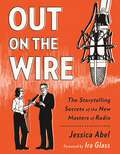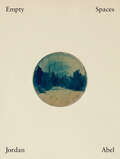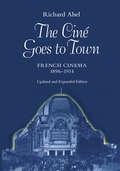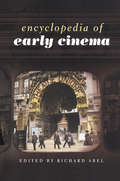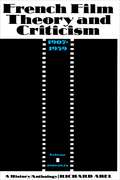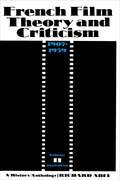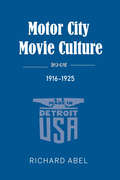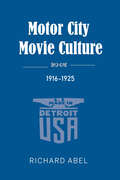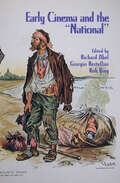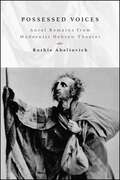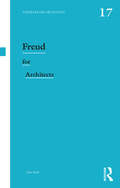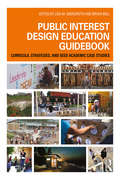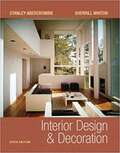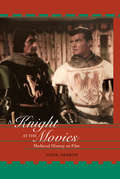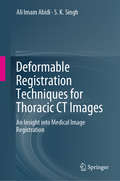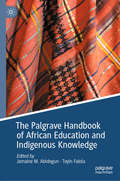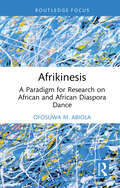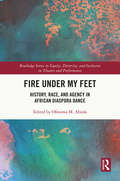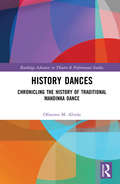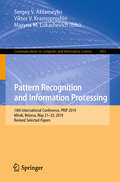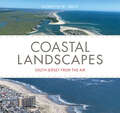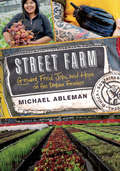- Table View
- List View
Out on the Wire: The Storytelling Secrets of the New Masters of Radio
by Jessica AbelA Library Journal Best Book of 2015Go behind the scenes of seven of today&’s most popular narrative radio shows and podcasts, including This American Life and RadioLab, in graphic narrative. Every week, millions of devoted fans tune in to or download This American Life, The Moth, Radiolab, Planet Money, Snap Judgment, Serial, Invisibilia and other narrative radio shows. Using personal stories to breathe life into complex ideas and issues, these beloved programs help us to understand ourselves and our world a little bit better. Each has a distinct style, but every one delivers stories that are brilliantly told and produced. Out on the Wire offers an unexpected window into this new kind of storytelling—one that literally illustrates the making of a purely auditory medium. With the help of This American Life's Ira Glass, Jessica Abel, a cartoonist and devotee of narrative radio, uncovers just how radio producers construct narrative, spilling some juicy insider details. Jad Abumrad of RadioLab talks about chasing moments of awe with scientists, while Planet Money&’s Robert Smith lets us in on his slightly goofy strategy for putting interviewees at ease. And Abel reveals how mad—really mad—Ira Glass becomes when he receives edits from his colleagues. Informative and engaging, Out on the Wire demonstrates that narrative radio and podcasts are creating some of the most exciting and innovative storytelling available today.
Empty Spaces
by Jordan AbelA hypnotic and mystifying exploration of land and legacy, investigating what it means to be an intergenerational, Indigenous survivor of Residential Schools Jordan Abel&’s new work grows out of the groundbreaking visual expression in his recently published NISHGA, a book that combined nonfiction with photography, concrete poetry, and literary inquiry. Whereas NISHGA integrated descriptions of the landscape from James Fenimore Cooper&’s settler classic The Last of the Mohicans into visual pieces, Empty Spaces reinscribes those words on the page itself, and in doing so subjects them to bold rewritings. Reimagining the nineteenth-century text from the contemporary perspective of an urban Nisga&’a person whose relationship to land and traditional knowledge and spiritual traditions was severed by colonial violence, Abel attempts to answer his research question of what it means to be Indigenous without access to familial territory. Engaging the land through fiction and metaphor, Abel creates an eerie, looping, and atmospheric rendering of place that evolves despite the violent and reckless histories of North America. The result is a bold and profound new vision of history that decenters human perception and forgoes Westernized ways of seeing. Rather than turning to characters and dialogue to explore truth, Abel invites us to instead understand that the land knows everything that can and will happen, even as the world lurches toward uncertainty.
The Cine Goes to Town: French Cinema, 1896-1914, Updated and Expanded Edition
by Richard AbelRichard Abel's magisterial new book radically rewrites the history of French cinema between 1896 and 1914, particularly during the years when Pathé-Frères, the first major corporation in the new industry, led the world in film production and distribution. Based on extensive investigation of rare archival films and documents, and drawing on recent social and cultural histories of turn-of-the-century France and the United States, his book provides new insights into the earliest history of the cinema.Abel tells how early French film entertainment changed from a cinema of attractions to the narrative format that Hollywood would so successfully exploit. He describes the popular genres of the era—comic chases, trick films and féeries, historical and biblical stories, family melodramas and grand guignol tales, crime and detective films—and shows the shift from short subjects to feature-length films. Cinema venues evolved along with the films as live music, color effects, and other new exhibiting techniques and practices drew larger and larger audiences. Abel explores the ways these early films mapped significant differences in French social life, helping to produce thoroughly bourgeois citizens for Third Republic France.The Ciné Goes to Town recovers early French cinema's unique contribution to the development of the mass culture industry. As the one-hundredth anniversary of cinema approaches, this compelling demonstration of film's role in the formation of social and national identity will attract a wide audience of film scholars, social and cultural historians, and film enthusiasts.
Encyclopedia of Early Cinema
by Richard AbelThis encyclopedia presents a wealth of information on early cinema history, with coverage of the techniques and equipment of film production, profiles of the pioneering directors and producers, analysis of individual films and the rapid growth of distinct film genres, and the emergence of something the world had never seen before - the movie star.The work also focuses on how the nature of film exhibition changed as the industry grew, and how the public's reception to films also changed. The pre-cinema period is closely examined to show those mass-cultural forms and practices - such as music hall and vaudeville - from within which cinema was to emerge. A perfect companion for any student of early cinema and film studies.
French Film Theory and Criticism, Volume 1: A History/Anthology, 1907-1939. Volume 1: 1907-1929
by Richard AbelThese two volumes examine a significant but previously neglected moment in French cultural history: the emergence of French film theory and criticism before the essays of André Bazin. Richard Abel has devised an organizational scheme of six nearly symmetrical periods that serve to "bite into" the discursive flow of early French writing on the cinema. Each of the periods is discussed in a separate and extensive historical introduction, with convincing explications of the various concepts current at the time. In each instance, Abel goes on to provide a complementary anthology of selected texts in translation. Amounting to a portable archive, these anthologies make available a rich selection of nearly one hundred and fifty important texts, most of them never before published in English.
French Film Theory and Criticism, Volume 2: A History/Anthology, 1907-1939. Volume 2: 1929-1939
by Richard AbelThese two volumes examine a significant but previously neglected moment in French cultural history: the emergence of French film theory and criticism before the essays of Andr Bazin. Richard Abel has devised an organizational scheme of six nearly symmetrical periods that serve to "bite into" the discursive flow of early French writing on the cinema. Each of the periods is discussed in a separate and extensive historical introduction, with convincing explications of the various concepts current at the time. In each instance, Abel goes on to provide a complementary anthology of selected texts in translation. Amounting to a portable archive, these anthologies make available a rich selection of nearly one hundred and fifty important texts, most of them never before published in English.
Menus for Movieland
by Richard AbelAt the turn of the past century, the main function of a newspaper was to offer "menus" by which readers could make sense of modern life and imagine how to order their daily lives. Among those menus in the mid-1910s were several that mediated the interests of movie manufacturers, distributors, exhibitors, and the rapidly expanding audience of fans. This writing about the movies arguably played a crucial role in the emergence of American popular film culture, negotiating among national, regional, and local interests to shape fans' ephemeral experience of moviegoing, their repeated encounters with the fantasy worlds of "movieland," and their attractions to certain stories and stars. Moreover, many of these weekend pages, daily columns, and film reviews were written and consumed by women, including one teenage girl who compiled a rare surviving set of scrapbooks. Based on extensive original research, Menus for Movieland substantially revises what moviegoing meant in the transition to what we now think of as Hollywood.
Motor City Movie Culture, 1916-1925
by Richard AbelMotor City Movie Culture, 1916–1925 is a broad textured look at Hollywood coming of age in a city with a burgeoning population and complex demographics. Richard Abel investigates the role of local Detroit organizations in producing, distributing, exhibiting, and publicizing films in an effort to make moviegoing part of everyday life. Tapping a wealth of primary source material—from newspapers, spatiotemporal maps, and city directories to rare trade journals, theater programs, and local newsreels—Abel shows how entrepreneurs worked to lure moviegoers from Detroit's diverse ethnic neighborhoods into the theaters. Covering topics such as distribution, programming practices, nonfiction film, and movie coverage in local newspapers, with entr'actes that dive deeper into the roles of key individuals and organizations, this book examines how efforts in regional metropolitan cities like Detroit worked alongside California studios and New York head offices to bolster a mass culture of moviegoing in the United States.
Motor City Movie Culture, 1916–1925
by Richard AbelA study of how the film industry came to flourish in Detroit in the early years as locals were lured into the new picture theaters. Motor City Movie Culture, 1916–1925 is a broad textured look at Hollywood coming of age in a city with a burgeoning population and complex demographics. Richard Abel investigates the role of local Detroit organizations in producing, distributing, exhibiting, and publicizing films in an effort to make moviegoing part of everyday life. Tapping a wealth of primary source material—from newspapers, spatiotemporal maps, and city directories to rare trade journals, theater programs, and local newsreels—Abel shows how entrepreneurs worked to lure moviegoers from Detroit&’s diverse ethnic neighborhoods into the theaters. Covering topics such as distribution, programming practices, nonfiction film, and movie coverage in local newspapers, with entr&’actes that dive deeper into the roles of key individuals and organizations, this book examines how efforts in regional metropolitan cities like Detroit worked alongside California studios and New York head offices to bolster a mass culture of moviegoing in the United States.
Motor City Movie Culture, 1916–1925
by Richard AbelA study of how the film industry came to flourish in Detroit in the early years as locals were lured into the new picture theaters. Motor City Movie Culture, 1916–1925 is a broad textured look at Hollywood coming of age in a city with a burgeoning population and complex demographics. Richard Abel investigates the role of local Detroit organizations in producing, distributing, exhibiting, and publicizing films in an effort to make moviegoing part of everyday life. Tapping a wealth of primary source material—from newspapers, spatiotemporal maps, and city directories to rare trade journals, theater programs, and local newsreels—Abel shows how entrepreneurs worked to lure moviegoers from Detroit&’s diverse ethnic neighborhoods into the theaters. Covering topics such as distribution, programming practices, nonfiction film, and movie coverage in local newspapers, with entr&’actes that dive deeper into the roles of key individuals and organizations, this book examines how efforts in regional metropolitan cities like Detroit worked alongside California studios and New York head offices to bolster a mass culture of moviegoing in the United States.
Early Cinema and the "National"
by Richard Abel Rob King Giorgio BertelliniWhile many studies have been written on national cinemas, Early Cinema and the "National" is the first anthology to focus on the concept of national film culture from a wide methodological spectrum of interests, including not only visual and narrative forms, but also international geopolitics, exhibition and marketing practices, and pressing linkages to national imageries. The essays in this richly illustrated, landmark anthology are devoted to reconsidering the nation as a framing category for writing cinema history. Many of the 34 contributors show that concepts of a national identity played a role in establishing the parameters of cinema's early development, from technological change to discourses of stardom, from emerging genres to intertitling practices. Yet, as others attest, national meanings could often become knotty in other contexts, when concepts of nationhood were contested in relation to colonial/imperial histories and regional configurations. Early Cinema and the "National" takes stock of a formative moment in cinema history, tracing the beginnings of the process whereby nations learned to imagine themselves through moving images.
Possessed Voices: Aural Remains from Modernist Hebrew Theater (SUNY series in Contemporary Jewish Literature and Culture)
by Ruthie AbeliovichFinalist for the 2020 Jordan Schnitzer Book Award in the category of Jews and the Arts: Music, Performance, and Visual presented by the Association for Jewish StudiesPossessed Voices tells the intriguing story of a largely unknown collection of audio recordings, which preserve performances of modernist interwar Hebrew plays. Ruthie Abeliovich focuses on four recordings: a 1931 recording of The Eternal Jew (1919/1923), a 1965 recording of The Dybbuk (1922), a 1961 radio play of The Golem (1925), and a 1952 radio play of Yaakov and Rachel (1928). Abeliovich traces the spoken language of modernist Hebrew theater as grounded in multiple modalities of expressive practices, including spoken Hebrew, Jewish liturgical sensibilities supplemented by Yiddish intonation and other vernacular accents, and in relation to prevalent theatrical forms. The book shows how these recorded performances provided Jewish immigrants from Europe with a venue for lamenting the decline of their home communities and for connecting their memories to the present. Analyzing sonic material against the backdrop of its artistic, cultural, and ideological contexts, Abeliovich develops a critical framework for the study of sound as a discipline in its own right in theater scholarship.
Freud for Architects (Thinkers for Architects)
by John AbellFreud for Architects explains what Freud offers to the understanding of architectural creativity and architectural experience, with case examples from early modern architecture to the present. Freud’s observations on the human psyche and its influence on culture and social behavior have generated a great deal of discussion since the 19th century. Yet, what Freud’s key ideas offer to the understanding of architectural creativity and experience has received little direct attention. That is partly because Freud opened the door to a place where conventional research in architecture has little traction, the unconscious. Adding to the difficulties, Freud’s collection of work is vast and daunting. Freud for Architects navigates Freud’s key ideas and bridges a chasm between architecture and psychoanalytic theory. The book highlights Freud’s ideas on the foundational developments of childhood, developments on which the adult psyche is based. It explains why and how the developmental stages could influence adult architectural preferences and preoccupations, spatial intuition, and beliefs about what is proper and right for architectural design. As such, Freud for Architects will be of great interest to students, practitioners, and scholars in a range of disciplines including architecture, psychoanalysis, and philosophy.
Public Interest Design Education Guidebook: Curricula, Strategies, and SEED Academic Case Studies (Public Interest Design Guidebooks)
by Lisa M. Abendroth Bryan BellPublic Interest Design Education Guidebook: Curricula, Strategies, and SEED Academic Case Studies presents the pedagogical framework and collective curriculum necessary to teach public interest designers. The second book in Routledge’s Public Interest Design Guidebook series, the editors and contributors feature a range of learning competencies supported by distinct teaching strategies where educational and community-originated goals unite. Written in a guidebook format that includes projects from across design disciplines, this book describes the learning deemed most critical to pursuing an inclusive, informed design practice that meets the diverse needs of both students and community partners. Featured chapter themes include Fundamental Skills, Intercultural Competencies, Engaging the Field Experience, Inclusive Iteration, and Evaluating Student Learning. The book consists of practice-based and applied learning constructs that bridge community-based research with engaged learning and design practice. SEED (Social Economic Environmental Design) academic case studies introduce teaching strategies that reinforce project-specific learning objectives where solving social, economic, and environmental issues unites the efforts of communities, student designers, and educators. This comprehensive publication also contains indices devoted to learning objectives cross-referenced from within the book as well as considerations for educational program development in public interest design. Whether you are a student of design, an educator, or a designer, the breadth of projects and teaching strategies provided here will empower you to excel in your pursuit of public interest design.
Interior Design and Decoration
by Stanley Abercrombie Sherrill WhitonAddressing interior design and decoration from the ancients to the moderns, this text describes the dominant influences of fashion design and focuses on the close relationship between interior design and the architecture of our times. <p><p> With the Sixth Edition of Interior Design and Decoration, Stanley Abercrombie continues the revival of this time-tested and well-respected text—first published in 1937—to make it meet the needs of today’s teachers and students. In his second revision of Sherrill Whiton’s classic text, Abercrombie presents the full history of interior design—during all periods and throughout all regions—in a manner that facilitates easy comparisons among different times, places, and styles.
A Knight at the Movies: Medieval History on Film
by John AberthImagining the Middle Ages is an unprecedented examination of the historical content of films depicting the medieval period from the 11th to the 15th centuries. Historians increasingly feel the need to weigh in on popular depictions of the past, since so much of the public's knowledge of history comes from popular mediums. Aberth dissects how each film interpreted the period, offering estimations of the historical accuracy of the works and demonstrating how they project their own contemporary era's obsessions and fears onto the past.
Deformable Registration Techniques for Thoracic CT Images: An Insight into Medical Image Registration
by Ali Imam Abidi S.K. SinghThis book focuses on novel approaches for thoracic computed tomography (CT) image registration and determination of respiratory motion models in a range of patient scenarios. It discusses the use of image registration processes to remove the inconsistencies between medical images acquired using different devices. In the context of comparative research and medical analysis, these methods are of immense value in image registration procedures, not just for thoracic CT images, but for all types of medical images in multiple modalities, and also in establishing a mean respiration motion model. Combined with advanced techniques, the methods proposed have the potential to advance the field of computer vision and help improve existing methods. The book is a valuable resource for those in the scientific community involved in modeling respiratory motion for a large number of people.
The Palgrave Handbook of African Education and Indigenous Knowledge
by Jamaine M. Abidogun Toyin FalolaThis handbook explores the evolution of African education in historical perspectives as well as the development within its three systems–Indigenous, Islamic, and Western education models—and how African societies have maintained and changed their approaches to education within and across these systems. African education continues to find itself at once preserving its knowledge, while integrating Islamic and Western aspects in order to compete within this global reality. Contributors take up issues and themes of the positioning, resistance, accommodation, and transformations of indigenous education in relationship to the introduction of Islamic and later Western education. Issues and themes raised acknowledge the contemporary development and positioning of indigenous education within African societies and provide understanding of how indigenous education works within individual societies and national frameworks as an essential part of African contemporary society.
Yoruba Art and Language
by Rowland AbiodunThe Yoruba was one of the most important civilizations of sub-Saharan Africa. While the high quality and range of its artistic and material production have long been recognized, the art of the Yoruba has been judged primarily according to the standards and principles of Western aesthetics. In this book, which merges the methods of art history, archaeology, and anthropology, Rowland Abiodun offers new insights into Yoruba art and material culture by examining them within the context of the civilization's cultural norms and values and, above all, the Yoruba language. Abiodun draws on his fluency and prodigious knowledge of Yoruba culture and language to dramatically enrich our understanding of Yoruba civilization and its arts. The book includes a companion website with audio clips of the Yoruba language, helping the reader better grasp the integral connection between art and language in Yoruba culture.
Afrikinesis: A Paradigm for Research on African and African Diaspora Dance (Routledge Advances in Theatre & Performance Studies)
by Ofosuwa M AbiolaThis book provides scholars and non-specialists alike with a roadmap for effectively conducting culturally aware, historically relevant research on African dance and on any dance style that contains African elements. This book explains why Western research paradigms are inadequate for research on Africana dance. It exposes the value of utilizing an appropriate research paradigm that offers researchers a broader perspective and a transparent, unfettered process for analysis in under-researched topics such as African and African diaspora dance styles. Researchers are introduced to the African dance aesthetic, characteristically African body movements, definitions of steps, understandings within African culture, and a host of other jewels that facilitate a deeper grasp on the subject and refine the quality of the scholar’s research, its findings, and its proficiency. This book will be of great interest to scholars of African dance studies.
Fire Under My Feet: History, Race, and Agency in African Diaspora Dance (Routledge Series in Equity, Diversity, and Inclusion in Theatre and Performance)
by Ofosuwa M. AbiolaFire Under My Feet seeks to expose the diverse, significant, and often under-researched historical and developmental phenomena revealed by studies in the dance systems of the African Diaspora. In the book, written documentation and diverse methodologies are buttressed by the experiences of those whose lives are built around the practice of African diaspora dance. Replete with original perspectives, this book makes a significant contribution to dance and African diaspora scholarship simultaneously. Most important, it highlights the work of researchers from Ecuador, India, Puerto Rico, the United States, and the United Kingdom, and it exposes under-researched and omitted voices of the African diaspora dance world of the aforesaid locations and Puerto Rico, Columbia, and Trinidad as well. This study showcases a blend of scholars, dance practitioners, and interdisciplinarity, and engages the relationship between African diaspora dance and the fields of history, performance studies, critical race theory, religion, identity, and black agency.
History Dances: Chronicling the History of Traditional Mandinka Dance (Routledge Advances in Theatre & Performance Studies)
by Ofosuwa M. AbiolaThe field of history is founded on the interrogation of written documents from the past. However, culture is the center of life in Africa. As a result, in the past – and to a degree in the present – the process for documenting events in Africa was not written, it was performed. History Dances: Chronicling the History of Traditional Mandinka Dance argues that a wealth of information is housed within traditional Mandinka dance and, consequently, the dances can be used as an African-derived primary source for writing African history. Ofosuwa M. Abiola highlights the overall value of studying Mandinka dance history specifically, and African dance history generally, as well as addressing the issue of scarcity with regard to primary sources for writing African history. History Dances proves to be a vital read for both undergraduate students and scholars in the fields of dance history, African history, performance studies, and cultural anthropology.
Pattern Recognition and Information Processing: 14th International Conference, PRIP 2019, Minsk, Belarus, May 21–23, 2019, Revised Selected Papers (Communications in Computer and Information Science #1055)
by Sergey V. Ablameyko Viktor V. Krasnoproshin Maryna M. LukashevichThis book constitutes the refereed proceedings of the 14th International Conference on Pattern Recognition and Information Processing, PRIP 2019, held in Minsk, Belarus, in May 2019. The 25 revised full papers were carefully reviewed and selected from 120 submissions. The papers of this volume are organized in topical sections on pattern recognition and image analysis; information processing and applications.
Coastal Landscapes: South Jersey from the Air
by Kenneth W. AbleNew Jersey has roughly one hundred and thirty miles of coastline, including a wide array of habitats from marshes to ocean beaches, each hosting a unique ecosystem. Yet these coastal landscapes are quite dynamic, changing rapidly as a result of commercial development, environmental protection movements, and of course climate change. Now more than ever, it is vital to document these landscapes before they disappear. Based on numerous aerial images from helicopter and drone flights between 2015 and 2021, this book provides extensive photographs and maps of the New Jersey coast, from the Pine Barrens to the ocean beaches. The text associated with each exceptional image describes it in detail, including its location, ecological setting, and relative position within the larger landscape. Author Kenneth Able, director of the Rutgers University Marine Field Station for over thirty years, has thoroughly ground-truthed each image by observations made through kayaks, boats, and wading through marshes. Calling upon his decades of expertise, Able paints a compelling portrait of coastal New Jersey’s stunning natural features, resources, history, and possible futures in an era of rising sea levels.
Street Farm: Growing Food, Jobs, and Hope on the Urban Frontier
by Michael AblemanStreet Farm is the inspirational account of residents in the notorious Low Track in Vancouver, British Columbia--one of the worst urban slums in North America--who joined together to create an urban farm as a means of addressing the chronic problems in their neighborhood. It is a story of recovery, of land and food, of people, and of the power of farming and nourishing others as a way to heal our world and ourselves. During the past seven years, Sole Food Street Farms--now North America's largest urban farm project--has transformed acres of vacant and contaminated urban land into street farms that grow artisan-quality fruits and vegetables. By providing jobs, agricultural training, and inclusion in a community of farmers and food lovers, the Sole Food project has empowered dozens of individuals with limited resources who are managing addiction and chronic mental health problems. Sole Food's mission is to encourage small farms in every urban neighborhood so that good food can be accessible to all, and to do so in a manner that allows everyone to participate in the process. In Street Farm, author-photographer-farmer Michael Ableman chronicles the challenges, growth, and success of this groundbreaking project and presents compelling portraits of the neighborhood residents-turned-farmers whose lives have been touched by it. Throughout, he also weaves his philosophy and insights about food and farming, as well as the fundamentals that are the underpinnings of success for both rural farms and urban farms. Street Farm will inspire individuals and communities everywhere by providing a clear vision for combining innovative farming methods with concrete social goals, all of which aim to create healthier and more resilient communities.
